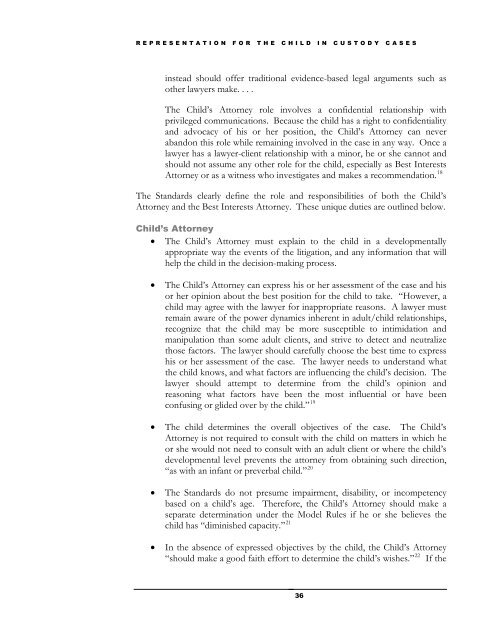A Judge’s Guide
A Judge’s Guide
A Judge’s Guide
Create successful ePaper yourself
Turn your PDF publications into a flip-book with our unique Google optimized e-Paper software.
REPRESENTATION FOR THE CHILD IN CUSTODY CASES<br />
instead should offer traditional evidence-based legal arguments such as<br />
other lawyers make. . . .<br />
The Child’s Attorney role involves a confidential relationship with<br />
privileged communications. Because the child has a right to confidentiality<br />
and advocacy of his or her position, the Child’s Attorney can never<br />
abandon this role while remaining involved in the case in any way. Once a<br />
lawyer has a lawyer-client relationship with a minor, he or she cannot and<br />
should not assume any other role for the child, especially as Best Interests<br />
Attorney or as a witness who investigates and makes a recommendation. 18<br />
The Standards clearly define the role and responsibilities of both the Child’s<br />
Attorney and the Best Interests Attorney. These unique duties are outlined below.<br />
Child’s Attorney<br />
The Child’s Attorney must explain to the child in a developmentally<br />
appropriate way the events of the litigation, and any information that will<br />
help the child in the decision-making process.<br />
The Child’s Attorney can express his or her assessment of the case and his<br />
or her opinion about the best position for the child to take. “However, a<br />
child may agree with the lawyer for inappropriate reasons. A lawyer must<br />
remain aware of the power dynamics inherent in adult/child relationships,<br />
recognize that the child may be more susceptible to intimidation and<br />
manipulation than some adult clients, and strive to detect and neutralize<br />
those factors. The lawyer should carefully choose the best time to express<br />
his or her assessment of the case. The lawyer needs to understand what<br />
the child knows, and what factors are influencing the child’s decision. The<br />
lawyer should attempt to determine from the child’s opinion and<br />
reasoning what factors have been the most influential or have been<br />
confusing or glided over by the child.” 19<br />
The child determines the overall objectives of the case. The Child’s<br />
Attorney is not required to consult with the child on matters in which he<br />
or she would not need to consult with an adult client or where the child’s<br />
developmental level prevents the attorney from obtaining such direction,<br />
“as with an infant or preverbal child.” 20<br />
The Standards do not presume impairment, disability, or incompetency<br />
based on a child’s age. Therefore, the Child’s Attorney should make a<br />
separate determination under the Model Rules if he or she believes the<br />
child has “diminished capacity.” 21<br />
In the absence of expressed objectives by the child, the Child’s Attorney<br />
“should make a good faith effort to determine the child’s wishes.” 22 If the<br />
36


